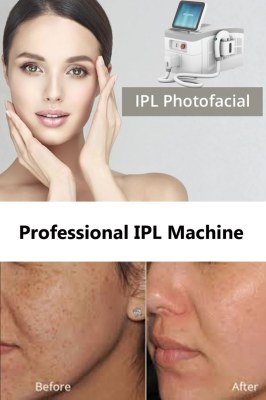Intense pulsed light IPL photofacial machine is a cosmetic skin treatment that may help reduce the signs of aging, remove unwanted hair, lighten darker patches of skin, and improve the appearance of scars and spider veins. IPL facial treatment works in a similar way to laser therapy. The difference is that where laser therapy delivers a single wavelength of light energy, IPL delivers multiple wavelengths. This means that IPL can treat a larger area of skin in a shorter time than laser therapy. Bestview Laser is a professional IPL machine manufacturer, we have IPL hair removal machine for sale. This article will explain how IPL works and what people use it for. It will also examine its safety and effectiveness and look at the possible risks and side effects of the procedure.
IPL uses light energy to target accurately and remove pigmented or damaged skin cells or hair follicles. Using a handheld device, a medical professional will target multiple wavelengths of light onto the skin. This light heats cells in the skin and breaks them down. The body then removes the damaged tissue naturally.
People may choose IPL as a treatment for a range of skin issues. These include:
1.Acne scars
2.Birthmarks
3.Rosacea, a condition that causes redness of the face
4.Hyperpigmentation, including liver or age spots and freckles
5.Melasma, a condition causing brown or gray-brown skin patches
6.Scars
7.Spider veins
8.Stretch marks
9.Sun damaged skin
10.Wrinkles
People may also commonly use it to remove unwanted hair or tattoos.
Safety, risks, and side effects of IPL treatment
IPL treatment is safe for most people but is not suitable for everyone. Pregnant women and people who are on blood thinners, for example, should avoid IPL.
Other factors that make people unsuitable for IPL treatment include:
1.Currently or recently taking the acne drug Accutane
2.Having active acne
3.Suffering from a skin resurfacing disorder
4.Being susceptible to keloid scarring
5.Having severe scarring
6.Having suffered severe sunburn recently
As with any medical procedure, IPL does carry the risk of complications. These include:
1.Pain
2.Skin discoloration
3.Swelling
4.Infection
5.Bleeding
6.Scarring
7.Crusting
How effective is IPL treatment?
The effectiveness of IPL treatment depends on many things. It works better on white or light brown skin than on darker skin, for example. Another factor is the kind of IPL equipment a healthcare professional uses during the procedure. Everyone responds differently to IPL, and most people will need multiple rounds of the treatment before they start to notice results.
Preparation before IPL treatment:
Anyone planning on having IPL treatment should speak to a dermatologist about the potential benefits, side effects, and complications. To prepare for the procedure, a dermatologist will usually ask people to avoid the following for 2 weeks:
1.Sunbathing and tanning beds
2.Waxing
3.Chemical peels
4.Collagen injections
Immediately before and after IPL therapy, people should also avoid using any perfume or deodorant on the treatment area. The American Society for Dermatological Surgery also advise people not to take any aspirin, anti-inflammatory drugs, or herbal supplements before the procedure. These medicines can contribute to the risk of bleeding.
What to expect:
A medical professional will use a handheld device to deliver light therapy. During the procedure, people may feel a pinching sensation. Some individuals have described this as a feeling similar to an elastic band being “snapped” on the skin. Many IPL providers will help people overcome this discomfort by offering a local anesthetic or chilling gel. The length and number of sessions needed will depend on each individual's treatment plan. It is worth noting that it can take anything up to several weeks to notice the results of IPL treatment.
Recovery:
Immediately after the IPL treatment procedure, the treated area may look red or pink. This tends to last for between 4 and 8 hours. People may also notice a stinging sensation in the 4 to 6 hours after IPL. This feeling may resemble that of having a mild sunburn. A moist cloth or cool pack can help ease the stinging. Swelling is also common, usually lasting for several days after the procedure. During the recovery period, people should avoid putting makeup or lotion on the treated area for 24 hours after the procedure or until all the swelling has gone. After this time, individuals should moisturize the treated area at least twice a day for a minimum of 3 months.
Other options:
IPL treatment may not be the best option for everybody. Some people find it too painful, while others are uncomfortable with the recovery time.
Fraxel treatment is a form of laser treatment that reduces the signs of aging. It is not painful, and most people only need one session rather than the multiple procedures that IPL requires. People can have Fraxel treatment on the face, neck, shoulders, and chest. As it is a laser treatment, however, it carries the same potential side effects as IPL.
Microdermabrasion is another option for people who want to rejuvenate the appearance of their skin. It removes the outer, dead layers of skin, revealing the fresh, newer skin underneath. Microdermabrasion results do not last as long as those of IPL or Fraxel treatment. In comparison with IPL, microdermabrasion may be:
1.Cheaper
2.Pain-free
3.Have fewer potential side effects
4.Have a shorter recovery time
In terms of hair removal, waxing, or shaving are common alternatives to IPL treatment.
Have you noticed changes in facial skin tone, inflammation or overactive small blood vessels?
Your skin tone and texture may have changed due to sun damage, aging, acne scarring and certain conditions, such as rosacea. You may have noticed overactive small blood vessels (capillaries), hyperpigmentation, discoloration, age spots/sun spots, broken capillaries, unwanted hair, fine lines or inflammation. When medications or topical treatments aren't helping your skin texture and tone, facial light therapy may be a good treatment option. IPL is one type of laser skin resurfacing.
How much does IPL treatment cost?
The cost of IPL treatment can vary depending on the number of treatment areas (face, neck, etc.) as well as the number of sessions needed to achieve your desired result. As treatment for a cosmetic condition, IPL typically is not covered by insurance, although there are some exceptions. Contact your doctor's office to get a cost estimate prior to your appointment.
What areas of concern can IPL treat?
1.Uneven skin texture, including fine lines
2.Uneven skin tone, such as sunspots, overactive capillaries and pigmentation
3.Unwanted facial hair
4.Chalazions and styes
5.Dry eyes and ocular surface disease
6.Ocular/facial rosacea and dry eye (blepharitis) caused by overactive blood vessels
7.Demodex mites (microscopic bugs that live on the eyelashes)
Ophthalmologists are experts in administering these treatments while protecting the health and safety of your eyes. Treatment can target your entire face, but also the eyelids and the orbital area.
How IPL works for facial rejuvenation
IPL technology removes both unwanted pigmentation and blood vessels from the skin. To ensure utmost comfort, your physician typically applies a topical numbing cream before treatment and uses air cooling during treatment. Depending on your specific concern, you can expect the session to last between 15 and 30 minutes. You may experience a warm or prickling sensation as the laser is applied to the skin, but the treatment is gentle and shouldn't feel uncomfortable or painful.
Results of IPL facial treatment. Typically, about three sessions are needed to have visible improvement in the skin texture and fine lines. Optimal results are achieved after three to five sessions in two-to-six-week intervals.
What to expect before and after your IPL facial treatment
How to prepare for your IPL facial treatment:
Inform your doctor if you have a history of fever blisters, cold sores, or cosmetic facial tattoos (including permanent or semi-permanent makeup).
Avoid sun exposure without sunscreen, self-tanning treatments, Botox™ injections, and filler injections for four to six weeks prior. Discontinue use of exfoliant products and products containing retinol or tretinoin one week prior. Avoid use of Accutane® or isotretinoin products six months prior. Stop using doxycycline or minocycline antibiotics three days prior. For your first treatment only, stop using prescription eye drops one week prior and don't use generic artificial tears the day of treatment.
What to know about recovery after IPL facial treatment:
You may experience a mild sunburn or burning sensation following treatment, which usually goes away within four to six hours. Your facial skin will be considered fragile for two to three days. Your doctor will give you these instructions and restrictions after treatment:
1.Moisturize your face daily
2.Don't wear makeup for two to three days
3.Use gentle facial cleansers
4.Don't rub the skin on your face, and avoid hot water
5.Don't exfoliate
6.Don't use any retinoids, tretinoins, alpha or beta hydroxy products, vitamin C products, or have facial chemical peels for one week
7.Avoid direct sunlight and use sunscreen
8.Avoid excessive heat or friction to the treated facial area (including strenuous exercise, saunas, etc.)
How IPL works for hair removal
IPL hair removal treatment is a noninvasive treatment that permanently reduces hair growth, resulting in smooth skin.
Highly controlled pulses of light are applied on the treated area and are selectively absorbed by the hair follicles beneath the skin surface. The absorbed light heats the hair follicles, which damages the regrowth potential of the follicle all without damaging the surrounding tissue.
Results of IPL for hair removal:
IPL hair removal treatment is generally administered in a series of four to six sessions, but your doctor can tell if you might require additional treatments. Multiple treatments are required in order to target the hair follicles in every stage of growth. You should start to notice a reduction in unwanted facial hair after the first treatment.
Summary
IPL is a cosmetic skin treatment. People may choose to undergo the procedure to reduce the signs of aging or remove unwanted hair. Other uses include reducing the severity of skin hyperpigmentation, such as freckles, birthmarks, or age spots. This type of light treatment tends to work best on people with lighter skin, and an individual will typically need multiple rounds of treatment. IPL is generally safe but can carry potential complications such as pain, swelling, and bleeding. Pregnant women should not undergo IPL treatment.
Location : HENAN NEW-TECH MARKET.NO 199, YANG JIN ROAD, JINSHUI DISTRICT ZHENGZHOU, CHINA., 450003 Zhengzhou,
Contact : Best Bvlaser, 0086 19503862093








